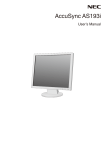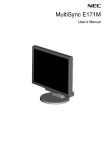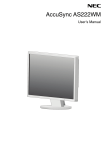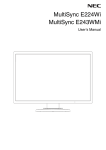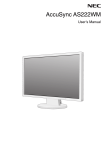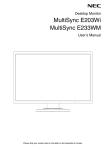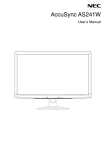Download NEC E232WMT
Transcript
MultiSync E232WMT User’s Manual Index Warning, Caution............................................................................................................................................English-1 Registration Information.................................................................................................................................English-2 Recommended use........................................................................................................................................English-3 Contents.........................................................................................................................................................English-5 Quick Start......................................................................................................................................................English-6 Controls..........................................................................................................................................................English-10 Specifications.................................................................................................................................................English-13 Troubleshooting..............................................................................................................................................English-14 TCO Certified Displays 6................................................................................................................................English-16 Manufacturer’s Recycling and Energy Information.........................................................................................English-17 TO PREVENT FIRE OR SHOCK HAZARDS, DO NOT EXPOSE THIS UNIT TO RAIN OR MOISTURE. ALSO, DO NOT USE THIS UNIT’S POLARIZED PLUG WITH AN EXTENSION CORD RECEPTACLE OR OTHER OUTLETS UNLESS THE PRONGS CAN BE FULLY INSERTED. REFRAIN FROM OPENING THE CABINET AS THERE ARE HIGH VOLTAGE COMPONENTS INSIDE. REFER SERVICING TO QUALIFIED SERVICE PERSONNEL. CAUTION: CAUTION TO REDUCE THE RISK OF ELECTRIC SHOCK, MAKE SURE POWER CORD IS UNPLUGGED FROM WALL SOCKET. TO FULLY DISENGAGE THE POWER TO THE UNIT, PLEASE DISCONNECT THE POWER CORD FROM THE AC OUTLET.DO NOT REMOVE COVER (OR BACK). NO USER SERVICEABLE PARTS INSIDE. REFER SERVICING TO QUALIFIED SERVICE PERSONNEL. This symbol warns user that uninsulated voltage within the unit may have sufficient magnitude to cause electric shock. Therefore, it is dangerous to make any kind of contact with any part inside this unit. This symbol alerts the user that important literature concerning the operation and maintenance of this unit has been included. Therefore, it should be read carefully in order to avoid any problems. CAUTION: Please use the power cord provided with this display in accordance with the table below. If a power cord is not supplied with this equipment, please contact your supplier. For all other cases, please use a power cord that matches the AC voltage of the power outlet and has been approved by and complies with the safety standard of your particular country. Plug Type North America European Continental U.K. Chinese Japanese U.S.A./Canada EU (except U.K.) U.K. China Japan 120* 230 230 220 100 Plug Shape Country Voltage *When operating the monitor with its AC 125-240V power supply, use a power supply cord that matches the power supply voltage of the AC power outlet being used. NOTE: This product can only be serviced in the country where it was purchased. Windows is a registered trademark of Microsoft Corporation. NEC is a registered trademark of NEC Corporation. ErgoDesign is a registered trademark of NEC Display Solutions, Ltd. in Austria, Benelux, Denmark, France, Germany, Italy, Norway, Spain, Sweden, U.K. Energy Star is a U.S. registered trademark. All other brands and product names are trademarks or registered trademarks of their respective owners. As an Energy Star® Partner, NEC Display Solutions of America, Inc. has determined that this product meets the Energy Star guidelines for energy efficiency. The Energy Star emblem does not represent EPA endorsement of any product or service. VESA is trademark in the United States and other countries owned by the Video Electronics Standards Association. HDMI, the HDMI logo and High-Definition Multimedia Interface are trademarks or registered trademarks of HDMI Licensing LLC in the United States and other countries. • The intended primary use of this product is as an Information Technical Equipment in an office or domestic environment. • The product is intended to be connected to a computer and is not intended for the display of television broadcast signals. English-1 English WARNING Registration Information FCC Information 1. Use the attached specified cables with the MultiSync E232WMT (L233QV) monitor so as not to interfere with radio and television reception. (1) The power supply cord you use must have been approved by and comply with the safety standards of U.S.A., and meet the following condition. Power supply cord Length Plug shape Non shield type, 3-conductor 1.8 m U.S.A (2) 2. Please use the supplied shielded video signal cable, 15-pin mini D-SUB to D-SUB cable or DVI-D to DVI-D cable. Use of other cables and adapters may cause interference with radio and television reception. This equipment has been tested and found to comply with the limits for a Class B digital device, pursuant to part 15 of the FCC Rules. These limits are designed to provide reasonable protection against harmful interference in a residential installation. This equipment generates, uses, and can radiate radio frequency energy, and, if not installed and used in accordance with the instructions, may cause harmful interference to radio communications. However, there is no guarantee that interference will not occur in a particular installation. If this equipment does cause harmful interference to radio or television reception, which can be determined by turning the equipment off and on, the user is encouraged to try to correct the interference by one or more of the following measures: • Reorient or relocate the receiving antenna. • Connect the equipment into an outlet on a circuit different from that to which the receiver is connected. • • Increase the separation between the equipment and receiver. Consult your dealer or an experienced radio/TV technician for help. If necessary, the user should contact the dealer or an experienced radio/television technician for additional suggestions. The user may find the following booklet, prepared by the Federal Communications Commission, helpful: “How to Identify and Resolve Radio-TV Interference Problems.” This booklet is available from the U.S. Government Printing Office, Washington, D.C., 20402, Stock No. 004-000-00345-4. Declaration of Conformity This device complies with Part 15 of FCC Rules. Operation is subject to the following two conditions. (1) This device may not cause harmful interference, and (2) this device must accept any interference received, including interference that may cause undesired operation. U.S. Responsible Party: NEC Display Solutions of America, Inc. Address: 500 Park Boulevard, Suite 1100 Itasca, Illinois 60143 Tel. No.: (630) 467-3000 Type of Product: Display Monitor Equipment Classification: Class B Peripheral Model: MultiSync E232WMT (L233QV) We hereby declare that the equipment specified above conforms to the technical standards as specified in the FCC Rules. English-2 Safety Precautions and Maintenance FOR OPTIMUM PERFORMANCE, PLEASE NOTE THE FOLLOWING WHEN SETTING UP AND USING THE LCD COLOR MONITOR: • DO NOT OPEN THE MONITOR. There are no user serviceable parts inside and opening or removing covers may expose you to dangerous shock hazards or other risks. Refer all servicing to qualified service personnel. • Do not spill any liquids into the cabinet or use your monitor near water. • Do not insert objects of any kind into the cabinet slots, as they may touch dangerous voltage points, which can be harmful or fatal or may cause electric shock, fire or equipment failure. • Do not place any heavy objects on the power cord. Damage to the cord may cause shock or fire. • Do not place this product on a sloping or unstable cart, stand or table, as the monitor may fall, causing serious damage to the monitor. • The power supply cord you use must have been approved by and comply with the safety standards of your country. (Type H05VV-F 3G 1mm2 should be used in Europe). • In UK, use a BS-approved power cord with molded plug having a black (5A) fuse installed for use with this monitor. • Do not place any objects onto the monitor and do not use the monitor outdoors. • Do not bend power cord. • Do not use monitor in high temperatured, humid, dusty, or oily areas. • Do not cover vent on monitor. • Vibration can damage the backlight. Do not install where the monitor will be exposed to continual vibration. • If monitor or glass is broken, do not come in contact with the liquid crystal and handle with care. • To prevent damage to the LCD monitor caused by tipping over due to earthquakes or other shocks, make sure to install the monitor in a stable location and take measures to prevent falling. Immediately turn off the power, unplug your monitor from the wall outlet and move to a safe location then refer servicing to qualified service personnel under the following conditions. If the monitor is used in this condition, the monitor may cause fall, fire and electric shock: • If the monitor stand has been cracked or peeled. • If the monitor has been wobbled. • If the monitor has an unusual odor. • When the power supply cord or plug is damaged. • If liquid has been spilled, or objects have fallen into the monitor. • If the monitor has been exposed to rain or water. • If the monitor has been dropped or the cabinet damaged. • If the monitor does not operate normally by following operating instructions. • Allow adequate ventilation around the monitor so that heat can properly dissipate. Do not block ventilated openings or place the monitor near a radiator or other heat sources. Do not put anything on top of monitor. CAUTION • The power cable connector is the primary means of detaching the system from the power supply. The monitor should be installed close to a power outlet which is easily accessible. • Handle with care when transporting. Save packaging for transporting. Image Persistence: Image persistence is when a residual or “ghost” image of a previous image remains visible on the screen. Unlike CRT monitors, LCD monitors’ image persistence is not permanent, but constant images being displayed for a long period of time should be avoided. To alleviate image persistence, turn off the monitor for as long as the previous image was displayed. For example, if an image was on the monitor for one hour and a residual image remains, the monitor should be turned off for one hour to erase the image. NOTE: As with all personal display devices, NEC DISPLAY SOLUTIONS recommends using a moving screen saver at regular intervals whenever the screen is idle or turning off the monitor when not in use. English-3 English Recommended use CORRECT PLACEMENT AND ADJUSTMENT OF THE MONITOR CAN REDUCE EYE, SHOULDER AND NECK FATIGUE. CHECK THE FOLLOWING WHEN YOU POSITION THE MONITOR: • For optimum performance, allow 20 minutes for the display to warm up. • Adjust the monitor height so that the top of the screen is at or slightly below eye level. Your eyes should look slightly downward when viewing the middle of the screen. • Position your monitor no closer than 40 cm (15.75 inches) and no further away than 70 cm (27.56 inches) from your eyes. The optimal distance is 50 cm (19.69 inches). • Rest your eyes periodically by focusing on an object at least 20 feet away. Blink often. • Position the monitor at a 90° angle to windows and other light sources to minimize glare and reflections. Adjust the monitor tilt so that ceiling lights do not reflect on your screen. • If reflected light makes it hard for you to see your screen, use an anti-glare filter. • Clean the LCD monitor surface with a lint-free, non-abrasive cloth. Avoid using any cleaning solution or glass cleaner! • Adjust the monitor’s brightness and contrast controls to enhance readability. • Use a document holder placed close to the screen. • Position whatever you are looking at most of the time (the screen or reference material) directly in front of you to minimize turning your head while you are typing. • Avoid displaying fixed patterns on the monitor for long periods of time to avoid image persistence (after-image effects). • Get regular eye checkups. Ergonomics To realize the maximum ergonomics benefits, we recommend the following: • To avoid eye fatigue, adjust the brightness to a moderate setting. Place a sheet of white paper next to the LCD screen for luminance reference. • Do not position the Contrast control to its maximum setting. • Use the preset Size and Position controls with standard signals. • Use the preset Color Setting. • Use non-interlaced signals with a vertical refresh rate of 60 Hz. • Do not use primary color blue on a dark background, as it is difficult to see and may produce eye fatigue due to insufficient contrast. Cleaning the Panel • When the panel is dusty, please gently wipe with a soft cloth. • Please do not rub the panel with hard or coarse material. • Please do not apply pressure to the panel surface. • Please do not use OA cleaner as it will cause deterioration or discoloration on the panel surface. Cleaning the Cabinet • Unplug the power supply • Gently wipe the cabinet with a soft cloth • To clean the cabinet, dampen the cloth with a neutral detergent and water, wipe the cabinet and follow with a dry cloth. NOTE: Many plastics are used on the surface of the cabinet. DO NOT clean with benzene, thinner, alkaline detergent, alcoholic system detergent, glass cleaner, wax, polish cleaner, soap powder, or insecticide. Do not touch rubber or vinyl to the cabinet for a long time. These types of fluids and fabrics can cause the paint to deteriorate, crack or peel. For more detailed information on setting up a healthy work environment, write to the American National Standard for Human Factors Engineering of Computer Workstations - ANSI/HFES 100-2007 - The Human Factors Society, Inc. P.O. Box 1369, Santa Monica, California 90406. English-4 English Contents Your new NEC monitor box* should contain the following: • MultiSync monitor with tilt/height adjust stand • Power Cord*1 • Video Signal Cable (DVI-D to DVI-D cable)*2 • Video Signal Cable (Mini D-SUB 15 pin to Mini D-SUB 15 pin) • USB Cable*3 • Audio Cable (ø 3.5 stereo mini plug) • Setup Manual. Mini D-SUB 15 pin to Mini D-SUB 15 pin Power Cord*1 Audio Cable Setup Ma nual Setup Manual * DVI-D to DVI-D cable*2 USB Cable*3 Remember to save your original box and packing material to transport or ship the monitor. * The type and number of power cords included will depend on the where the LCD monitor is to be shipped. When more than one power cord is included, please use the power cord that matches the AC voltage of the power outlet and has been approved by and complies with the safety standard of your particular country. 1 *2 Single link DVI cable. *3 USB 3.0 cable. English-5 Quick Start To connect the LCD monitor to your system, follow these instructions: NOTE: Make sure to read “Recommended use” (page 3) before installation. 1. Turn off the power of your computer. 2. For a PC with DVI digital output: Connect the DVI signal cable to the connector of the display card in your system (Figure A.1). Tighten all screws. For a PC with Analog output: Connect a 15-pin mini D-SUB signal cable to the connector of the display card in your system (Figure A.2). For a PC with HDMI output: Connect the HDMI cable to the connector of the display card in your system (Figure A.3). Figure A.1 HDMI cable (not included) Figure A.2 Figure A.3 English-6 NOTE: Handle with care when tilting the monitor screen. 4. Connect all cables to the appropriate connectors (Figure C.1). For using the USB cable, connect the B type connector to the USB upstream port on the right back side of the monitor and the A type connector to the downstream port on the computer (Figure C.1a). If using the cable from a USB device, plug into one of the downstream ports of the monitor. NOTE: Incorrect cable connections may cause abnormal operation, damage display quality/components of LCD module and/ or shorten the module’s life. A Type USB 3.0 Downstream A Type B Type B Type Audio Input D-SUB Headphone USB Upstream DVI HDMI Figure C.1a USB 3.0 Downstream Power cord Figure C.1 5. Connect one end of the power cord to the AC inlet on the back of the monitor and the other end to the power outlet. NOTE: Please refer to Caution section of this manual for proper selection of AC power cord. 6. Turn on the computer and the monitor by pressing the power key on the side bezel (Figure E.1). 7. No Touch Auto Adjust automatically adjusts the monitor to optimal settings upon initial setup. For further adjustments, use the following OSD controls: • Contrast (Only when Eco Mode Off) • H.SIZE (Analog input only) • Fine (Analog input only) Refer to the Controls section of this User’s Manual for a full description of these OSD controls. NOTE: • When the USB cable of this monitor is connected to the computer, the driver is automatically installed on the computer and the touch panel, camera, and microphone are activated. When it is connected for the first time, it may take time for the computer to recognize the monitor. • If you have any problems, please refer to the Troubleshooting section of this User’s Manual. English-7 English 3. Place hands on each side of the monitor to tilt the LCD panel and lift up to the highest position. Camera Microphone LED The white light is lit up while the camera is in operation. Microphone UP DOWN AUTO LED Indicates that the power is on or off. MENU POWER Figure E.1 Raise and Lower Monitor Screen To raise or lower screen, place a hand on each side of the monitor and lift or lower to the desired height (Figure RL.1). NOTE: Handle with care when raising or lowering the monitor screen. Figure RL.1 Tilt Grasp both sides of the monitor screen with your hands and adjust the tilt as desired (Figure TS.1). Figure TS.1 NOTE: Handle with care when tilting the monitor screen. Flexible Arm Installation This LCD monitor is designed for use with a flexible arm. To prepare the monitor for alternate mounting purposes: • Follow the instructions provided by the manufacturer of the display mount. • To meet the safety requirements, the mounting stand must be able to support the weight of the monitor and be UL-certified. English-8 English Remove Monitor Stand for Mounting To prepare the monitor for alternate mounting purposes: 1. Disconnect all cables. 2. Place a hand on each side of the monitor and lift up to the highest position. 3. Place monitor face down on a non-abrasive surface (Figure S.1). NOTE: Handle with care when the monitor is facing down. 4. Remove 2 bottom screws first (Figure S.2). 5. Remove 2 top screws (Figure S.3). NOTE: In order to avoid stand drop, when removing screws, please support stand with your hand. Figure S.1 6. Remove the stand (Figure S.4). 7. The monitor is now ready for mounting in an alternate manner. 8. Connect the cables to the back of the monitor. NOTE: Handle with care when removing monitor stand. Figure S.2 Figure S.3 Figure S.4 Mount Flexible Arm This LCD monitor is designed for use with a flexible arm. 1. Follow the instructions on how Remove Monitor Stand for Mounting to remove the stand. 2. Use the 4 screws removed from the stand to attach the arm to the monitor (Figure F.1). Caution: Use ONLY the screws (4 pcs) that were removed from the stand to avoid damage to the monitor or stand. To meet the safety requirements, the monitor must be mounted to an arm which guaranties the necessary stability under consideration of the weight of the monitor. The LCD monitor should only be used with an approved arm (e.g. GS mark). Thickness of Bracket (Arm) 2.0~3.2 mm 100 mm 100 mm Weight of LCD assembly: 5.3 kg Figure F.1 English-9 Controls OSD (On-Screen Display) control keys on the side of the monitor function are as follows: To access OSD menu, press the MENU key. To change signal input, press the AUTO/EXIT key. NOTE: Exit OSD in order to change signal input. UP DOWN AUTO MENU POWER 1 2 3 4 5 6 1 s / UP Navigates up or increases values through the OSD Control menu. Adjusts VOLUME directly while the OSD menu is off. Selects Audio Source from HDMI and Line-in while the OSD menu is off. (HDMI input with audio only) 2 t / DOWN Navigates down or decreases values through the OSD Control menu. Select the Eco Mode directly while the OSD menu is off. 3 AUTO / EXIT Exits the OSD sub menu. Exits OSD Control menu. Selects the video input connectors directly while the OSD menu is off. Hold the button to adjust H.SIZE, Fine and H/V Position automatically while the OSD menu is off. (Analog input only) 4 MENU / ENTER Accesses OSD menu. Enters to OSD Control menu. During power off: Hold MENU key and push POWER key to enter / exit OSD Lock mode. 5 POWER Turns the monitor on and off. 6 LED Indicates that the power is on or off. English-10 English BRIGHTNESS / CONTRAST Contrast (Only when Eco Mode Off) Adjusts the overall image and background screen brightness by input signal level. Brightness (Only when Eco Mode Off) Adjusts the overall image and background screen brightness. Eco Mode Decreases the amount of power consumption by reducing the brightness level. Off :No function. 1 - 5:Sets Brightness level to 90% - 20%, and Contrast to 50%. Dynamic On :Setting that adjusts the brightness by detecting the screen’s black areas and optimizes it. Off :No function. Image Setup H.SIZE (Analog input only) Adjusts the horizontal size by increasing or decreasing this setting. Fine (Analog input only) Improves focus, clarity and image stability by increasing or decreasing this setting. H. Position (Analog input only) Controls horizontal image position within the display area of the LCD. V. Position (Analog input only) Controls vertical image position within the display area of the LCD. Expansion Sets the zoom method. FULL :The image is expanded to full screen, regardless of the resolution. ASPECT:The image is expanded without changing the aspect ratio. Color Color Color presets select the desired color setting. Warm:Warm color setting. Native:Original color presented by the LCD panel. Cool :Cool color setting. sRGB:sRGB mode dramatically improves the color fidelity in the desktop environment by a single standard RGB color space. With this color-supported environment, the user could easily and confidently communicate color without further color management overhead in most common situations. Contrast, Brightness, and Eco Mode are fixed settings. The user cannot change them. User :User color setting. Red, Green, Blue Red, Green or Blue colors are adjustable while User mode is selected. English-11 OSD Setup Timeout You can select how long the monitor waits after the last touch of a key to shut off the OSD menu. Language Selects the language used by the OSD. Extra Input Select Changes the video input source. Reset Allows you to reset all OSD control settings back to the factory settings. Information Provides information about the current resolution display and the horizontal and vertical frequencies. Indicates the model name and serial numbers of your monitor. OSD Warning No signal This function gives a warning when there is no horizontal or vertical sync. Out of Range This function gives a warning when the input video signal is not supported. English-12 Monitor Specifications MultiSync E232WMT Notes LCD Module Diagonal: Viewable Image Size: Native Resolution (Pixel Count): 58.42 cm/23.0 inches 58.42 cm/23.0 inches 1920 x 1080 Active matrix; thin film transistor (TFT) liquid crystal display (LCD); 0.265 mm dot pitch; 250 cd/m2 white luminance; 1000:1 contrast ratio (typical), (15000:1 Contrast ratio, Dynamic). Touch Panel Projected Capacitive touch panel Multi-touch (10 points) Input Signal DVI: DVI-D 24pin: Digital RGB DVI (HDCP) VGA: 15pin Mini D-sub: Analog RGB Sync 0.7 Vp-p/75 ohm Separate sync.TTL level Positive/Negative HDMI: HDMI Connector: Digital YUV Digital RGB HDMI 16,777,216 Depends on display card used. 31.5 kHz to 81.1 kHz (Analog) 31.5 kHz to 81.1 kHz (Digital) 56 Hz to 76 Hz Automatically Automatically Automatically Display Colours Synchronization Range Horizontal: Vertical: Viewing Angle Left/Right: Up/Down: ±85° (CR > 10) ±85° (CR > 10) Image Formation Time 5ms (Gray to gray Typ.) Resolutions Supported 720 x 400*1: VGA text 640 x 480*1 @ 60 Hz to 75 Hz 800 x 600*1 @ 56 Hz to 75 Hz 832 x 624*1 @ 75 Hz 1024 x 768*1 @ 60 Hz to 75 Hz 1152 x 864*1 @ 75 Hz 1152 x 870*1 @ 75 Hz 1280 x 1024*1 @ 60 Hz to 75 Hz 1680 x 1050*1 @ 60 Hz 1920 x 1080 @ 60 Hz......................................... Active Display Area Horiz.: Vert.: USB Hub I/F: Port: Load Current: Some systems may not support all modes listed. NEC DISPLAY SOLUTIONS cites recommended. 509.2 mm/20.0 inches 286.4 mm/11.3 inches USB Specification Revision 3.0 Upstream 1 USB 3.0 Downstream 4 Maximum 0.9 A per port for USB 3.0 AUDIO AUDIO Input: STEREO Mini Jack: HDMI Connector: Analog Audio Digital Audio Stereo L/R 500mV rms 20 Kohm PCM 2ch 32, 44.1, 48 kHz (16/20/24bit) Headphone Output: STEREO Mini Jack: Speakers Practical Audio Output: Headphone Impedance 32 Ohm 1.0 W + 1.0 W Camera 2.0 Mp (1920 x 1080 up to 30 fps) Interface: USB 2.0, Support UVC Microphone Stereo digital microphone Interface: USB 2.0, Support UAC Supported Operating system Microsoft Windows 7(SP1) / 8 / 8.1, 32 / 64 bit Power Supply AC 100-240 V ~ 50/60 Hz Current Rating 1.0 - 0.5 A (with USB and Audio) Dimensions 561.0 mm (W) x 362.8 - 416.7 mm (H) x 249.7 mm (D) 22.1 inches (W) x 14.3 - 16.4 inches (H) x 9.8 inches (D) 53.8 mm Height Adjustment: Weight 7.6 kg (16.8 lbs) / Without stand: 5.3 kg (11.7 lbs) Environmental Considerations Operating Temperature: Humidity: Altitude: Storage Temperature: Humidity: Altitude: 5°C to 35°C/41°F to 95°F 20% to 80% 0 to 6,562 Feet/0 to 2,000 m -10°C to 60°C/14°F to 140°F 10% to 85% 0 to 40,000 Feet/0 to 12,192 m *1 Interpolated Resolutions: When resolutions are shown that are lower than the pixel count of the LCD module, text may appear different. This is normal and necessary for all current fl at panel technologies when displaying non-native resolutions full screen. In fl at panel technologies, each dot on the screen is actually one pixel, so to expand resolutions to full screen, an interpolation of the resolution must be done. NOTE: Technical specifications are subject to change without notice. English-13 English Specifications Troubleshooting No picture • The signal cable should be completely connected to the display card/computer. • The display card should be completely seated in its slot. • The monitor does not support DisplayPort converter signal. • Power Switch and computer power switch should be in the ON position. • Check to make sure that a supported mode has been selected on the display card or system being used. (Please consult display card or system manual to change graphics mode.) • Check the monitor and your display card with respect to compatibility and recommended settings. • Check the signal cable connector for bent or pushed-in pins. • Check the signal input, “DVI-D”, “HDMI” or “D-Sub”. Power Key does not respond • Unplug the power cord of the monitor from the AC outlet to turn off and reset the monitor. • When something is stuck on the bezel, key becomes unresponsive. Image Persistence • Image persistence is when a residual or “ghost” image of a previous image remains visible on the screen. Unlike CRT monitors, LCD monitors’ image persistence is not permanent, but constant images being displayed for a long period of time should be avoided. To alleviate image persistence, turn off the monitor for as long as the previous image was displayed. For example, if an image was on the monitor for one hour and a residual image remains, the monitor should be turned off for one hour to erase the image. NOTE: As with all personal display devices, NEC DISPLAY SOLUTIONS recommends using a moving screen saver at regular intervals whenever the screen is idle or turning off the monitor when not in use. Message “Out of Range” is displayed (screen is either blank or shows rough images only) • Image is displayed only roughly (pixels are missing) and OSD warning “Out of Range” is displayed: Either signal clock or resolution is too high. Choose one of the supported modes. • OSD warning “Out of Range” is displayed on a blank screen: Signal frequency is out of range. Choose one of the supported modes. Image is unstable, unfocused or swimming is apparent • Signal cable should be completely attached to the computer. • Use the OSD Image Adjust controls to focus and adjust display by increasing or decreasing the fine adjustment. When the display mode is changed, the OSD Image Adjust settings may need to be readjusted. • Check the monitor and your display card with respect to compatibility and recommended signal timings. • If your text is garbled, change the video mode to non-interlace and use 60Hz refresh rate. LED on monitor is not lit (no blue or amber color can be seen) • Power Switch should be in the ON position and power cord should be connected. Picture is not as bright • Make sure Eco Mode is turned off. • Signal cable should be completely attached. • LCD brightness degradation occurs due to long-term usage or extreme cold conditions. Display image is not sized properly • Use the OSD Image Adjust controls to increase or decrease the Coarse adjustment. • Check to make sure that a supported mode has been selected on the display card or system being used. (Please consult display card or system manual to change graphics mode.) No Video • If no video is present on the screen, turn the Power button off and on again. • Make certain the computer is not in a power-saving mode (touch the keyboard or mouse). No Sound • Make sure the audio cable is proper connected. • Check to see if mute is activated. • Check the volume in the OSD menu. • If headphones are connected, the speakers will not emit any sound. English-14 • Check to make sure the USB cable is properly connected. Refer to your USB devise User’s Manual. • Check if the USB upstream port on the monitor is connected to the USB downstream port on the computer. And make sure the computer is ON. The touch panel does not work • Check to make sure the USB cable is properly connected. • If using Windows 7, apply Service Pack (SP1). The touch panel recognizes a position that differs greatly from the actual touched position • Make an adjustment (calibration) in the Tablet PC settings of the Windows Control Panel. A part of the touch panel does not react • Press the POWER key to restart the display. Do not touch the touch panel until the screen is displayed. The speaker volume is too high or low • Press the UP key to adjust the volume. • Adjust the speaker volume in the sound settings of the Windows Control Panel. The camera and microphone does not work • Check to make sure the USB cable is properly connected. • If using Windows 7, apply Service Pack (SP1). The microphone volume is too high or low • Adjust the microphone volume in the Sound settings for the application in use or in the Windows Control Panel. English-15 English USB Hub does not operate TCO Certified Displays 6 Congratulations! This product is TCO Certified – for Sustainable IT TCO Certified is an international third party sustainability certification for IT products. TCO Certified ensures that the manufacture, use and recycling of IT products reflect environmental, social and economic responsibility. Every TCO Certified product model is verified by an accredited independent test laboratory. This product has been verified to meet all the criteria in TCO Certified, including: Corporate Social Responsibility Socially responsible production - working conditions and labor law in manufacturing country Energy Efficiency Energy efficiency of product and power supply. Energy Star compliant, where applicable Environmental Management System Manufacturer must be certified according to either ISO 14001 or EMAS Minimization of Hazardous Substances Limits on cadmium, mercury, lead & hexavalent chromium including requirements for mercury-free products, halogenated substances and hazardous flame retardants Design for Recycling Coding of plastics for easy recycling. Limit on the number of different plastics used. Product Lifetime, Product Take Back Minimum one-year product warranty. Minimum three-year availability of spare parts. Product takeback Packaging Limits on hazardous substances in product packaging. Packaging prepared for recycling Ergonomic, User-centered design Visual ergonomics in products with a display. Adjustability for user comfort (displays, headsets) Acoustic performance – protection against sound spikes (headsets) and fan noise (projectors, computers) Ergonomically designed keyboard (notebooks) Electrical Safety, minimal electro-magnetic Emissions Third Party Testing All certified product models have been tested in an independent, accredited laboratory. A detailed criteria set is available for download at www.tcodevelopment.com, where you can also find a searchable database of all TCO Certified IT products. TCO Development, the organization behind TCO Certified, has been an international driver in the field of Sustainable IT for 20 years. Criteria in TCO Certified are developed in collaboration with scientists, experts, users and manufacturers. Organizations around the world rely on TCO Certified as a tool to help them reach their sustainable IT goals. We are owned by TCO, a non-profit organization representing office workers. TCO Development is headquartered in Stockholm, Sweden, with regional presence in North America and Asia. For more information, please visit www.tcodevelopment.com English-16 NEC DISPLAY SOLUTIONS is strongly committed to environmental protection and sees recycling as one of the company’s top priorities in trying to minimize the burden placed on the environment. We are engaged in developing environmentally-friendly products, and always strive to help define and comply with the latest independent standards from agencies such as ISO (International Organisation for Standardization) and TCO (Swedish Trades Union). Disposing of your old NEC product The aim of recycling is to gain an environmental benefit by means of re-use, upgrading, reconditioning or reclamation of material. Dedicated recycling sites ensure that environmentally harmful components are properly handled and securely disposed. To ensure the best recycling of our products, NEC DISPLAY SOLUTIONS offers a variety of recycling procedures and gives advice on how to handle the product in an environmentally sensitive way, once it has reached the end of its life. All required information concerning the disposal of the product and country-specific information on recycling facilities can be found on our following websites: http://www.nec-display-solutions.com/greencompany/ (in Europe), http://www.nec-display.com (in Japan) or http://www.necdisplay.com (in USA). Energy Saving This monitor features an advanced energy saving capability. When a VESA Display Power Management Signalling (DPMS) Standard signal is sent to the monitor, the Energy Saving mode is activated. The monitor enters a single Energy Saving mode. Mode Power consumption LED colour Maximum Operation 52 W Blue Normal Operation (at TCO testing) 23 W Default setting, USB/Audio sleeping Blue Energy Saving Mode 0.3 W Amber Off Mode 0.25 W Unlit WEEE Mark (European Directive 2012/19/EU) Within the European Union EU-wide legislation, as implemented in each Member State, requires that waste electrical and electronic products carrying the mark (left) must be disposed of separately from normal household waste. This includes monitors and electrical accessories, such as signal cables or power cords. When you need to dispose of your NEC display products, please follow the guidance of your local authority, or ask the shop where you purchased the product, or if applicable, follow any agreements made between yourself and NEC. The mark on electrical and electronic products only applies to the current European Union Member States. Outside the European Union If you wish to dispose of used electrical and electronic products outside the European Union, please contact your local authority so as to comply with the correct disposal method. English-17 English Manufacturer’s Recycling and Energy Information




















